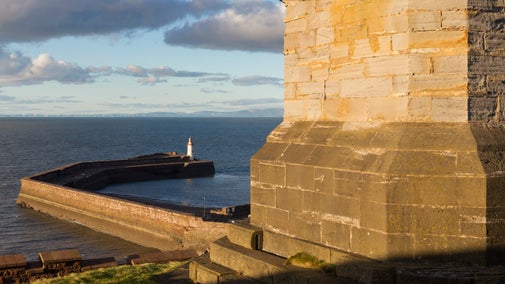
Donate
Everyone needs nature, now more than ever. Donate today and you could help people and nature to thrive at the places we care for.

The work we have been putting in to restore this stretch of land is really starting to show with the wildflower meadows on Whitehaven Coast coming into bloom each summer and an increase in typical coastal heather. Come and see the mosaic of habitat types change through the seasons and dance with the sea breeze.
When the National Trust took over the management of the meadows on the Whitehaven Coast, the first step to restoring them was to thin out the grasslands which had been left fallow with the decline in industrial activity. We started taking hay crops, making sure to leave cutting till after the 1st of August to allow for any wildflower seeds to ripen and drop. Over time, with the organic material being removed each year, the nutrients from the soil becomes depleted which results in a shorter sward with less grass. To help give wildflowers a fighting chance, yellow rattle seed was also spread. This hemiparasitic plant is often called the meadow make as it weakens the grasses and allows for wildflowers to become established. Over time, changing the management to a nutrient stripping regime has seen an increase in the variety and quantity of wildflowers on the coast, including a dramatic increase in orchids.
To avoid using pesticides, every year we hand weed the flower rich grasslands at Haig to remove thistles, docks and ragwort as they would soon dominate and draw nutrients from deeper in the soil. As these species are beneficial to wildlife, they are left in other sections of the field which are being managed differently. We have also been trying to increase the early nectar and pollen availability as well as the biodiversity and flowering period along the path and at entry points to the site. Here, with help from our volunteers, bulb planting, wildflower plug planting and seeding takes place every year through our partnership projects. These plants include English bluebells, primrose, corn flower, corn marigold, heather, gorse, snowdrops, wild daffodil, wild tulip and the list goes on. We have also planted many fruit trees and bushes including apples, pears, cherries, plums, damsons, gooseberries, elderberries and currants which we continue to care for and so hopefully, no matter the month, there will be a flower or fruit somewhere on site for everyone to enjoy.

Meadows have certainly suffered rapid decline and it is a high priority to expand them but heather is also a very important part of our plan for the continuing restoration and management of the coast. Lowland heath habitat has itself undergone a massive loss of area over the last century and would have been the natural coastal habitat here before people interfered with the land. Now the healthand is fragmented and reduced while being confined mostly to the cliff edges (themselves recognized for their importance as a Site of Special Scientific Interest). In an effort to conserve and expand this priority habitat, we have so far planted over 6000 heather plug plants and continue to encourage the heathland on the seaward side of the coastal path .
You may find that many places look rather scruffy and unkept during the winter and although it may look like we are simply taking a break, the long uncut vegetation provides important habitats for over wintering animals. This is why we have a longer cutting rotation which avoids too much disturbance. Here bees, butterflies, moths and flys can take shelter and reptiles, mammals and birds can make their homes and hide from predators. The patchwork of habitat types provided by the trees, bushes, long grasses and low growing plants is important for supporting multispecies conservation rather than just focussing on a few target ones. Sometimes good management means knowing when to leave things alone.
This is of course is something everyone can do in their own garden by leaving piles of leaves, logs, rocks etc for animals and insects to shelter in over the colder months.

With your ongoing support, we're able to continue our vital conservation work. Thank you for helping to protect these special places.

Everyone needs nature, now more than ever. Donate today and you could help people and nature to thrive at the places we care for.
There’s lots to discover on the Whitehaven Coast, from carpets of colourful wildflowers to thousands of nesting seabirds. Find out more.

The Whitehaven Coast offers more than just sea views and a colourful coast: discover an under-sea coalmine, fog horn station and eighteenth-century harbour.

We believe that nature, beauty and history are for everyone. That’s why we’re supporting wildlife, protecting historic sites and more. Find out about our work.

Read about our strategy, which focuses on restoring nature, ending unequal access and inspiring more people.

Find out how we're planting and establish 20 million trees that will absorb carbon and help tackle climate change.